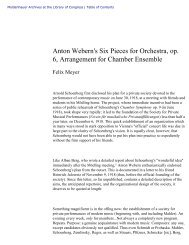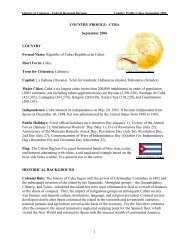1 - American Memory
1 - American Memory
1 - American Memory
You also want an ePaper? Increase the reach of your titles
YUMPU automatically turns print PDFs into web optimized ePapers that Google loves.
32<br />
The county's vital sugar industry which exports its total produc-<br />
tion to tlie west coast was beset with problems. The dock tieup forced<br />
at least one company to fly in equipment at tremendously higher<br />
prices. Availability of storage space was a serious problem as raw<br />
sugar was literally dumped on makeshift storage areas on the docks.<br />
The inability of Hawaii's sugar companies to get their product to<br />
their mainland markets seriously hampered their competitive strength<br />
with other producing areas. The local sugar industry suffered large<br />
financial losses during the prolonged maritime dispute and this in-<br />
dustry is in no position to afford it.<br />
Even under normal circumstances, sugar experiences subpar rates<br />
of return. With added cost from new environmental protection regu-<br />
lations, rising operating costs, and increasing competition, set-backs<br />
created by dock tieup can no longer be absorbed. Gentlemen, I can-<br />
not overstress the importance of this industry to our county. There<br />
are about 4,000 workers directly employed in this industry out of a<br />
total employment of 29,000. Related jobs to this industry would ac-<br />
count for another 4,000.<br />
Both small and the large firms need and depend upon surface<br />
vessels for its very survival. Businesses are forced to pass on these<br />
additional costs at a time when consumers can least afford it. During<br />
the west coast tieup of 1971, consumer food prices in Hawaii rose 4.5<br />
percent compared to a decline of 0.3 percent by the Nation as a whole.<br />
It must also be remembered that the major citj' of the State, Honolulu,<br />
already has one of the highest costs of living in the Nation—in some<br />
cases more than 20 percent above the U.S. average. Coupled with price<br />
increases are the layoffs which occurred as a direct result of the dock<br />
tieup. In November 1971, the County of Hawaii's unemployment rate<br />
rose to a high of 7 percent, the highest since the year 1950.<br />
The County of Hawaii did everything possible to alleviate the<br />
impact of the shipping tieup. We declared a limited state of emer-<br />
gency so that county storage space could be utilized by private indus-<br />
try. Our civil defense agency began monitoring food and medical sup-<br />
Elies [Exhibit II (see p. 44)] while the Department of Research and<br />
development conducted surveys of businesses [Exhibit III (see<br />
p. 90)]. The county assisted in the State emergency loan program<br />
for the hardest hit small businesses [Exhibit IV (see p. 114)]. We<br />
coordinated the Big Island's allocation of supplies which were brought<br />
in by a State chartered ship. This ship brought in emergency supplies<br />
of food and animal feed. Because of the wage-price freeze in 1971,<br />
private entrepreneurs were forced to absorb added costs of air freight,<br />
alternative shipping lines, storage space, and additional finance<br />
charges.<br />
The consumer suffered by being forced to pay higher prices and was<br />
forced to ration or stockpile some of his basic necessities. Entire con-<br />
struction jobs were halted because one subcontractor could not get his<br />
necessary supplies to complete his work. Despite employers' u*<br />
extended vacations, make-work products and shorter ^'<br />
day strike in 1971 resulted in over 300 layoffs in ou<br />
ipated layoffs involved several hundred additional<br />
these numbers do not represent a large figiire comp<br />
problems, it is critical to a county of our size.<br />
i i



![Albert Einstein Papers [finding aid]. Library of Congress. [PDF ...](https://img.yumpu.com/21604228/1/190x245/albert-einstein-papers-finding-aid-library-of-congress-pdf-.jpg?quality=85)





![American Colony in Jerusalem Collection [finding aid]. Library of ...](https://img.yumpu.com/17941275/1/190x245/american-colony-in-jerusalem-collection-finding-aid-library-of-.jpg?quality=85)



![Piccard Family Papers [finding aid]. - American Memory - Library of ...](https://img.yumpu.com/17941234/1/190x245/piccard-family-papers-finding-aid-american-memory-library-of-.jpg?quality=85)


